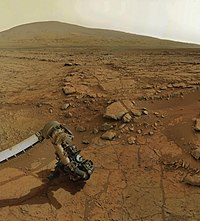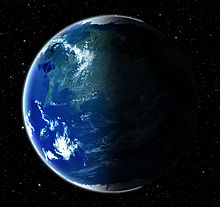

 |
| This article is one of a series on: |
| Life in the universe |
|---|
| Outline |
| Planetary habitability in the Solar System |
| Life outside the Solar System |
| Habitability of... |
|
|

The habitability of F-type main-sequence star (oryellow-white dwarf) systems is disputed due to the shorter lifetimes (3-8 Gyrs as opposed to 9-15 Gyrs for G stars) and higher levels of UV radiation. Indeed, F0 stars (7,400 K, 1.6 M☉︎, 1.7 R☉︎, ~7 L☉︎) are considered by many scientists as the hottest and most massive stars capable of supporting habitable planets. A planet orbiting an F-type star at the Earth boundary within the HZ would receive 2.5 (F9 star) to 7.1 (F0 star) times the UV that Earth gets from the sun.[1]
One study on planets and their moons orbiting stars form F5 to F9.5 concluded that exoplanets/moons around exoplanets orbiting in habitable zones around F-type stars would receive excessive UV damage as compared to the Earth.[2] If half a billion years is assumed as the amount of time it took for life to evolve,[1] then the highest spectral type considerable for life-bearing planets' stars is ~B8 (12,300 K, 3.3 M☉︎, 2.8 R☉︎, ~160 L☉︎), making F-type stars habitable in terms of lifetime. Still, it took 3 billion years to establish complexity, ruling out all stars hotter than A9, and 4.5 billion years to establish a technological civilization, ruling out all stars hotter than F2. Putting lifetime concerns aside, life on primordial Earth likely started in an underwater (and far underwater) environment anyway, and the water keeps the UV from reaching life-forms. In fact, it is possible that more UV could jumpstart the genesis and evolution of life, fulfilling main-sequence deadlines.[1] In addition, hotter stars would have wider habitable zones (2.0-3.7 AU for an F0 star and 1.1-2.2 AU for an F8 star as opposed to 0.8-1.7 AU for the Solar System), which would be another advantage of looking for habitable planets around F- and A-type stars.[2] If UV does indeed prove to be primarily problematic, then according to,[3] a planet orbiting at the Early Mars limit around an F8 star would actually be better off than Earth, receiving only 95% of the Earth's UV irradiation, and atmospheric attenuation would decrease even a Venus-like (in terms of stellar flux) planet around an F0 star's UV irradiation to less than 1/4 that of Earth. The best case would be an Earth-like planet at the Early Mars limit with attenuation around an F8-type star, where UV irradiance is 3.7% Earth's.[3]

According to,[3] the greatest change in UV irradiance occurs in a planet orbiting an F0 star with >1.5 M☉︎, as opposed to an F8 or F9 star with ≤1.2 M☉︎. The most dangerous phase in a star's life for potentially habitable planets orbiting it would be the earliest, between the star's formation and its 500,000,000th birthday, especially emphasized (again) on the more massive side of the F-star spectrum. The study even concludes that in some cases (i.e. a planet at the outer edge of the habitable zone around an old F5 or F8 star), a planet can even receive less, not more, UV than an Earth twin would.[3]
According to the Kepler data, M-type stars supposedly had more Earth-sized planets than larger, Sunlike (where the term is broad, meaning any FGK star) stars. However, in recent years, the Gaia space telescope has exposed Kepler's flaws, making it apparent that Earth-sized planets around red dwarfs are no more common than around FGK stars. As a result, the habitability of F-type stars is not impaired by the overall frequency of Earth-sized planets around them. However, it does show that Earth-size planets should be extremely uncommon (<0.1%) in the habitable zones of their stars.[4] So, instead of exoplanets, some studies focus mainly on exomoons orbiting Jupiter-like planets that fall within the habitable zone.[2] Alternatively, a study done by NASA with the same telescope gave a result saying that up to 50% of stars with temperatures between 4,300 (K6) and 7,300 (F0) K had habitable planets, and the number increased to 75% when the optimistic habitable zone was used.[5]
The habitability of F-type systems may be impaired, though, by the fact that they make up only 3% of the stars in the Milky way, compared to 6-8% for G-types, 12-13% for K-types, and ~70% for red dwarfs. Further study is required to make decisive conclusions about the frequency of habitable planets around F-type stars.[3][5]

As of 2023[update], there are no known potentially habitable exoplanets around F-type stars, but some unconfirmed Kepler candidates many be potentially habitable, including KOI-4878.01,[6] KOI-7040.01, KOI-6676.01, KOI-5202.01, and KOI-5236.01. Upsilon Andromedae has a Jupiter-like planet in the habitable zone and could therefore have habitable exomoons.[7] HD 10647 also has such a planet, which has a mass of >0.94 Jupiter masses and orbits at the outer frontier of the habitable zone.[8]
KOI-4878.01 is a potentially habitable exoplanet candidate orbiting an F8-type star. It is Earth-sized, with a period of 449 days and a semi-major axis of 1.137 AU. The equilibrium temperature is 258 K (−15 °C; 5 °F), and it gets just 1.04 times the light that Earth gets from the Sun. It could be the most Earth-like planet ever found (ESI = 0.98) if it is confirmed, despite its hotter and more massive star (stellar properties are not taken into account in ESI calculation). With a purely watery composition, the mass would be ~4 Mars masses (0.4 Earths), and with a pure iron composition, the mass would be 3 Earths.[6][9]
Upsilon Andromedae is another F8-type star, and the primary star in a wide binary system, in the constellation of Andromeda. It has 3 confirmed, Jovian planets, and planet "d" orbits in the star's extended habitable zone on a 1267-day year. It orbits near the outer edge, at 2.5 AU, and has a minimum mass of 4.6 Jupiters.[7] The habitability potential is therefore in possible Earth-like exomoons and not in the planet itself. It was the first multiple-planet system to be found around a main-sequence star (as well as, consequently, an F star) and is shown to be dynamically stable in all scenarios.[7]
|
| |||||||
|---|---|---|---|---|---|---|---|
| Events and objects |
| ||||||
| Signals of interest |
| ||||||
| Life in the Universe |
| ||||||
| Planetary habitability |
| ||||||
| Space missions |
| ||||||
| Interstellar communication |
| ||||||
| Types of alleged extraterrestrial beings |
| ||||||
| Hypotheses |
| ||||||
| Fermi paradox solutions |
| ||||||
| Related topics |
| ||||||